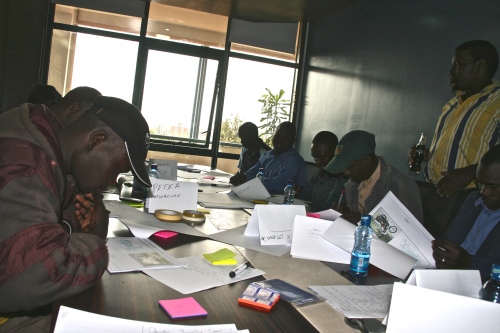Veeel’s adventures on the African continent continue, as we went to Kenya a month ago. For one of our clients we are developing a product for the Kenyan market and I finally got to meet the market! An exiting moment, since it was my first time on the African continent and I immediately got to work with the locals. This work existed out of doing creative sessions with different types of users of the product, who together construct the market. The experiences I gained from that, made me realize that there is a clear added value of doing these sessions. In this blog I will elaborate on our trip to Kenya and elaborate on the session we did there.
First a little background. I was talking about users, but who are they? Our specific users are Kenyan men with one wife and two kids. Their daily income ranges between 5-10 US Dollars and their highest education is secondary school. All these numbers are on average. Luckily their English was all quite good, so we could communicate directly with each other. In the creative sessions, we wanted to find out what their life’s look like, their feelings about the product, what their knowledge of the product was and what improvements they want on the product.
We prepared the session at home, on the Prinsengracht. At Veeel there is many knowledge on setting up sessions, however a creative session in a developing country is something different. I used the IDEO Human Centered Toolkit (http://www.ideo.com/work/human-centered-design-toolkit/) as well as the literature of Jan Chipchase (http://janchipchase.com) to try to adapt our session structure the best as we could to the Kenyan user context. I found these resources very helpful in the process. Without expectations and with flexibility in mind, we got onto the plane to Nairobi. And eight hours later, we stepped right into our first session of the week.
The setting was ideal; a nice room with a big table and good chairs, writing and drawing material, an airco, all the material that we brought from home and a beamer to present. All the ten users that we invited were on time, so we were ready to start. The beginning was interesting: it immediately was clear that the men were very motivated to make something of the session. We guided them into an open discussion and within 30 minutes, the shyness was completely disappeared. It is normal for these Kenyan men to respond in socially desirable way but during the session we noticed the honesty with which they all were telling their stories. During the day, we treated various topics around the product concept and the user insights literally flew over the table.

And that’s where the added value of the creative session comes by. When you ask users in a questionnaire about their insights, the results will stay on a superficial level and only general conclusions come out of this method of user research. The creative sessions we did in Kenya produced insights into the user’s thought on the product, as well as a look into his feeling and way of living. This results in concrete solutions, concrete design directions and an advanced knowledge on the user. I believe that these insights are not only important for design, but also important for marketing, R&D, logistics and strategy of a company. And off course, it works well in combination of the good old research questionnaire…
Back to the session. The day flew by and before I knew it, it was time to close off the day. The men were tired of all the talking and thinking, which made them feel good. We were exhausted by all the new impressions. After we said thank you, one of the men initiated a prayer, which we couldn’t refuse off course. And there we sat with the ten men, praying, for us and the success of our project; unforgettable.



Plaats een reactie